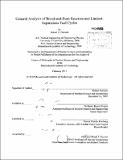General analysis of breed-and-burn reactors and limited-separations fuel cycles
Author(s)
Petroski, Robert C
DownloadFull printable version (70.66Mb)
Other Contributors
Massachusetts Institute of Technology. Dept. of Nuclear Science and Engineering.
Advisor
Benoit Forget.
Terms of use
Metadata
Show full item recordAbstract
A new theoretical framework is introduced, the "neutron excess" concept, which is useful for analyzing breed-and-burn (B&B) reactors and their fuel cycles. Based on this concept, a set of methods has been developed which allows a broad comparison of B&B reactors using different fuels, structural materials, and coolants. This new approach allows important reactor and fuelcycle parameters to be approximated quickly, without the need for a full core design, including minimum burnup/irradiation damage and reactor fleet doubling time. Two general configurations of B&B reactors are considered: a "minimum-burnup" version in which fuel elements can be shuffled in three dimensions, and a "linear-assembly" version composed of conventional linear assemblies that are shuffled radially. Based on studies of different core compositions, the best options for minimizing fuel burnup and material DPA are metal fuel (with a strong dependence on alloy content), the type of steel that allows the lowest structure volume fraction, and helium coolant. If sufficient fuel performance margin exists, sodium coolant can be substituted in place of helium to achieve higher power densities at a modest burnup and DPA penalty. For a minimum-burnup B&B reactor, reasonably achievable minimum DPA values are on the order of 250-350 DPA in steel, while axial peaking in a linear-assembly B&B reactor raises minimum DPA to over 450 DPA. By recycling used B&B fuel in a limited-separations (without full actinide separations) fuel cycle, there is potential for sodium-cooled B&B reactors to achieve fleet doubling times of less than one decade, although this result is highly sensitive to the reactor core composition employed as well as thermal hydraulic performance.
Description
Thesis (Ph. D.)--Massachusetts Institute of Technology, Dept. of Nuclear Science and Engineering, February 2011. Cataloged from PDF version of thesis. "February 2011." Includes bibliographical references (p. 348-351).
Date issued
2011Department
Massachusetts Institute of Technology. Department of Nuclear Science and EngineeringPublisher
Massachusetts Institute of Technology
Keywords
Nuclear Science and Engineering.